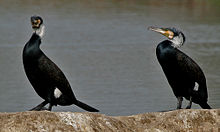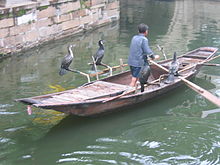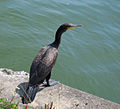- Great Cormorant
-
Great Cormorant 
Phalacrocorax carbo Conservation status Scientific classification Kingdom: Animalia Phylum: Chordata Class: Aves Order: Pelecaniformes Family: Phalacrocoracidae Genus: Phalacrocorax Species: P. carbo Binomial name Phalacrocorax carbo
(Linnaeus, 1758)The Great Cormorant (Phalacrocorax carbo), known as the Great Black Cormorant across the Northern Hemisphere, the Black Cormorant in Australia and the Black Shag further south in New Zealand, is a widespread member of the cormorant family of seabirds. It breeds in much of the Old World and the Atlantic coast of North America.
Contents
Description
The Great Cormorant is a large black bird, but there is a wide variation in size in the species wide range. Weight is reported from 1.5 kg (3.3 lbs)[1] to 5.3 kg (11.7 lbs),[2] with a typical range from 2.6 to 3.7 kg (5.7-8.2 lbs).[3] Length can vary from 70 to 102 cm (28–40 in) and wingspan from 121 to 160 cm (48–63 in). It has a longish tail and yellow throat-patch. Adults have white thigh patches in the breeding season. In European waters it can be distinguished from the Common Shag by its larger size, heavier build, thicker bill, lack of a crest and plumage without any green tinge.
In eastern North America, it is similarly larger and bulkier than Double-crested Cormorant, and the latter species has more yellow on the throat and bill.
Variations
A very rare variation of the Great Cormorant is caused by albinism. The Phalacrocorax carbo albino suffers from loss of eyesight and/or hearing, thus it rarely manages to survive in the wild.[citation needed]
Distribution
This is a very common and widespread bird species. It feeds on the sea, in estuaries, and on freshwater lakes and rivers. Northern birds migrate south and winter along any coast that is well-supplied with fish.
The type subspecies, P. c. carbo, is found mainly in Atlantic waters and nearby inland areas: on western European coasts and south to North Africa, the Faroe Islands, Iceland and Greenland; and on the eastern seaboard of North America, though in America it breeds only in the north of its range, in the Canadian maritime provinces.
The subspecies found in Australasian waters, P. carbo novaehollandiae, has a crest. In New Zealand it is known as the Black Shag or by its Māori name; Kawau.[5] The syntype is in the collection of the Museum of New Zealand Te Papa Tongarewa.[6]The 80–100 cm long White-breasted Cormorant P. c. lucidus found in sub-Saharan Africa, has a white neck and breast. It is often treated as a full species, Phalacrocorax lucidus (e.g. Sibley & Monroe, 1990, Sinclair, Hockey and Tarboton, 2002)
In addition to the Australasian and African forms, Phalacrocorax carbo novaehollandiae and P. carbo lucidus mentioned above, other geographically distinct subspecies are recognised, including P. c. sinensis (western Europe to east Asia), P. c. maroccanus (north-western Africa), and P. c. hannedae (Japan).
Some authors treat all these as allospecies of a P. carbo superspecies group.
Behaviour
The Great Cormorant breeds mainly on coasts, nesting on cliffs or in trees (which are eventually killed by the droppings), but also increasingly inland. 3-4 eggs are laid in a nest of seaweed or twigs.
The Great Cormorant can dive to considerable depths, but often feeds in shallow water. It frequently brings prey to the surface. A wide variety of fish are taken: cormorants are often noticed eating eels, but this may reflect the considerable time taken to subdue an eel and position it for swallowing, rather than any dominance of eels in the diet. In British waters, dive times of 20–30 seconds are common, with a recovery time on the surface around a third of the dive time.
Relationships with humans
Many fishermen see in the Great Cormorant a competitor for fish. Because of this it was nearly hunted to extinction in the past. Thanks to conservation efforts its numbers increased. At the moment there are about 1.2 million birds in Europe (based on winter counts. Late summer counts would show higher numbers).[7] Increasing populations have once again brought the cormorant into conflict with fisheries.[8][9] For example, in Britain, where inland breeding was once uncommon, there are now increasing numbers of birds breeding inland, and many inland fish farms and fisheries now claim to be suffering high losses due to these birds. In the UK each year some licences are issued to shoot specified numbers of cormorants in order to help reduce predation, it is however still illegal to kill a bird without such a licence.
Cormorant fishing is practiced in China, Japan, and elsewhere around the globe. In it, fishermen tie a line around the throats of cormorants, tight enough to prevent swallowing, and deploy them from small boats. The cormorants catch fish without being able to fully swallow them, and the fishermen are able to retrieve the fish simply by forcing open the cormorants' mouths, apparently engaging the regurgitation reflex.
In Norway cormorant is a traditional game bird. Each year ca. 10,000 cormorants are shot to be eaten.[10] In North Norway, cormorants are traditionally seen as semi-sacred.[citation needed] It is regarded as good luck to have cormorants gather near your village or settlement. An old legend states that people who die far out at sea, their bodies never recovered, spend eternity on the island Utrøst - which can only occasionally be found by mortals. The inhabitants of Utrøst can only visit their homes in the shape of cormorants.
Various views and plumages
-
In flight breeding-plumage South-west Queensland, Australia
-
A colony of Great Cormorants in Juodkrantė, Lithiuania, and damage to the trees in which they are nesting
-
Immature flying in Kolkata, West Bengal, India
-
Mai Po, Hong Kong
-
Drying wings, Tasmania, Australia
-
In flight at edge of River Mawddach, Wales, estuary
-
Resting at the side of the Albert Canal, Belgium
-
Close up of a Great Cormorant used for fishing in Erhai Lake, Yunnan, China
-
Great Cormorant, Abu Dhabi, UAE
-
A Great Comorant in Victoria, Australia.
References
- ^ http://www3.interscience.wiley.com/journal/118658278/abstract
- ^ http://www.thecanadianencyclopedia.com/index.cfm?PgNm=TCE&Params=A1ARTA0001923 A
- ^ http://www.birds.cornell.edu/AllAboutBirds/BirdGuide/Great_Cormorant.html
- ^ "Phalacrocorax carbo Albino (Great Cormorant, Great Black Cormorant)". MCH Portal: The Art and Science of Fishkeeping. June 14, 2011. http://www.mchportal.com/photography-galleries/macro-and-nature-mainmenu-52/birds-mainmenu-54/869-phalacrocorax-carbo-cormorant-albino.html. Retrieved June 27, 2011.
- ^ Barrie Heather and Hugh Robertson, "The Field guide to the Birds of New Zealand"(revised edition), Viking, 2005
- ^ "Phalacrocorax carbo novaehollandiae; syntype". Collections Online. Museum of New Zealand Te Papa Tongarewa. http://collections.tepapa.govt.nz/objectdetails.aspx?oid=358520. Retrieved 18 July 2010.
- ^ Wetland International Cormorant Researg Group: Cormorants in the western Palearctic, Distribution and numbers on a wider European scale; ;[1]
- ^ FAO publication: Workshop on a European Cormorant management Plan, 20–21 November 2007;[2] EIFAC, European Inland Fisheries Advisory Commission
- ^ European Parliament resolution of 4 December 2008: "on the adoption of a European Cormorant Management Plan to minimise the increasing impact of cormorants on fish stocks, fishing and aquaculture"; http://www.europarl.europa.eu/sides/getDoc.do?type=TA&reference=P6-TA-2008-0583&language=EN&ring=A6-2008-0434
- ^ Reducing the conflict between Cormorants and fisheries on a pan-European scale, REDCAFE, Final Report; page 12: "Around 10,000 adult Cormorants (of the ‘Atlantic’ carbo race) are hunted legally as game in Norway outside the breeding season."; http://www.intercafeproject.net/pdf/REDCAFEFINALREPORT.pdf
- BirdLife International (2004). Phalacrocorax carbo. 2006. IUCN Red List of Threatened Species. IUCN 2006. www.iucnredlist.org. Retrieved on 12 May 2006. Database entry includes justification for why this species is of least concern
- Sibley, C. G., & Monroe, B. L. (1990). Distribution and taxonomy of birds of the world. New Haven CT: Yale University Press.
- Ian Sinclair, Phil Hockey and Warwick Tarboton, SASOL Birds of Southern Africa (Struik 2002) ISBN 1-86872-721-1
External links
- http://www.mchportal.com/photography-galleries/macro-and-nature-mainmenu-52/birds-mainmenu-54/869-phalacrocorax-carbo-cormorant-albino.html
- Great Cormorant videos, photos & sounds on the Internet Bird Collection
- Ageing and sexing (PDF) by Javier Blasco-Zumeta
Categories:- IUCN Red List least concern species
- Birds of Greenland
- Phalacrocorax
- Birds of Asia
- Birds of Australia
- Birds of Kenya
- Birds of Armenia
- Birds of Afghanistan
- Birds of Pakistan
- Birds of Palestine
- Birds of Bhutan
- Birds of India
- Birds of Sri Lanka
- Birds of Nepal
- Birds of Bahrain
- Birds of Lithuania
- Birds of China
- Birds of Europe
- Birds of the Faroe Islands
- Birds of Southeast Asia
- Birds of Bangladesh
- Birds of Burma
- Birds of Vietnam
- Birds of Laos
- Birds of Cambodia
- Birds of Thailand
- Birds of Malaysia
- Birds of Turkey
- Birds of Brunei
- Birds of Indonesia
- Birds of the Philippines
- Birds of South Australia
- Birds of Tasmania
- Birds of Western Australia
- Birds of New Zealand
- British Isles coastal fauna
- Birds of Gibraltar
Wikimedia Foundation. 2010.




















